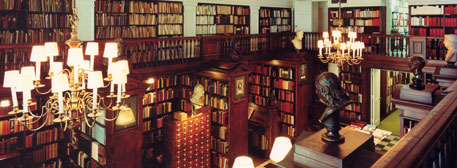275 Rare Diminutive Texts and Bindings To Be Seen From Patricia Pistner's Collection

City University of New York photo
Thousands of years before books were contained within a hand-held technological tablet or phone, there were cuneiform tablets no bigger than the size of a quarter. On view through May 19, 2019 in the second floor gallery of the Grolier Club are 275 rare diminutive texts and bindings from around the world that have been created over the span of 4,500 years. Size matters: these tiny tomes range in size from a maximum of four inches to less than one millimeter. Drawn from the collection of Patricia J. Pistner, the exhibition represents the history of the book in miniature form.
Image: Almanac, written in the style of Nuremberg writing masters, Diocese of Bamberg, c. 1450. Illustrated manuscript on vellum, with seven colorful astronomical and astrological circular diagrams, one with a multi-colored patterned centerpiece, with a pinhole for a volvelle. 77 x 52 mm, 3 x 2.” Collection of Patricia J. Pistner
A Matter of Size: Miniature Bindings & Texts from the Collection of Patricia J. Pistner includes cuneiform tablets and other antiquities, medieval manuscripts and early printed materials, books and bindings by women, imprints of Benjamin Franklin and Abraham Lincoln, as well as contemporary design bindings and artists’ books.
The exhibition is selected and organized by Pistner, along with Jan Storm van Leeuwen, former keeper of rare bindings at the Royal Library in The Hague and winner of the ILAB Breslauer Prize for Bibliography for his important study Dutch Decorated Binding in the 18th Century.
A collector of miniature books for over thirty years, Pistner’s love for very small tomes began at the age of seven when she began “publishing” tiny books for her first doll’s house. As an adult, her passion was reignited after being inspired to fill the small library shelves of the miniature French townhouse she had commissioned.
“The plan to fill that library with real, readable, printed miniature books led to assembling the most aesthetically compelling, representative samples of the history of the book in the smallest formats,” says Pistner. “My hope is that fellow bibliophiles find tomes here that spark their interest and lead to an increased interest in and respect for the format.”
Highlights include: 
-
Cuneiform Tablets and other examples of ancient texts dating from 2500 BCE.
-
Hyakumantō-darani. Nara, Japan: c. 764–770 CE. Among the oldest block printed texts, housed in its original wooden pagoda.
-
Almanac, written in the style of Nuremberg writing masters, Diocese of Bamberg, c. 1450. Illustrated manuscript on vellum, with seven colorful astronomical and astrological circular diagrams, one with a multi-colored patterned centerpiece, with a pinhole for a volvelle.
-
Septem Psalmi poenitentiales, cum alijs multis devotissimo orationibus. Ac Kalendario Gregoriano. Venetiis: Nicolaus Misserinus, 1593. Measuring a mere 2.4” tall, this binding has rock crystal covers painted in reverse in the verre églomisé depicting St. Francis receiving the stigmata and the Adoration of the Magi.
-
Enchiridion p[re]clare ecclesie Sarum …. [Book of Hours, Use of Salisbury]. Paris: Widow Thielman Kerver, 1528. Printed by Yolande Bonhomme, the only female printer in Paris and daughter of the famous printer and bookseller, Pasquier Bonhomme. This elaborate mosaic binding by Lortic was done in the 19th century for Charles-Louis de Bourbon (bookplate). The book is in Latin but the captions are in English.
-
Bird’s Egg Nécessaire for Sewing Kit, with Étrennes a l'innocence [including an almanac], Paris: 1820. A very rare type of object, which was not made for any practical purpose, but is a thing of beauty and was probably given by a young man to his beloved.
-
Bibliothèque portative du voyageur, 33 vols. 1801- 1804. Napoleonic era traveling library housed in a book-shaped case contains a collection of works written by the most famous French writers.
-
The Proclamation of Emancipation. 1862. The first separate printing in book form of the Emancipation Proclamation that the Union Army distributed in the South.
Editor's Note: See the ArtsSummary photos of the exhibit ...
Alphabet Magic: A Centennial Exhibition of the Work of Hermann & Gudrun Zapf
Upcoming in the Exhibition Hall:
Poet of the Body: New York's Walt Whitman: May 15 - July 27, 2019
More Articles
- Not Perhaps Too Late? A Source for Holiday Gifts You May Not Have Thought Of
- The Strong Museum: Home to International Center for the History of Electronic Games, the National Toy Hall of Fame, the World Video Game Hall of Fame
- From Harvard Medical School, Via the Maryland Office of the Chief Medical Examiner: Murder Is Her Hobby, Frances Glessner Lee and The Nutshell Studies of Unexplained Death
- Pow! Capturing Superheroes, Chess & Comics and Ladies’ Knight: A Female Perspective on Chess at the World Chess Hall of Fame
- Gulliver’s Gate: New York’s Magical Miniature World Where You Could Spend Weeks Here and Still Uncover New Things
- Optics, Illusion and Paper Cut-Out Scenes: Paper Peep Shows at the Victoria and Albert Museum
- Another Scout Report Post: Comforts of a Luxury Cruise, Grammarly, To Live and Dine in L.A., Privacy Palette
- An Elegant Society: Adam Buck, Artist in the Age of Jane Austen
- Gridiron Cards at the Met: Grange, Thorpe, Washington, Unitas and Rockne
- Beauty's Legacy, Material Opulence and Personal Excess: Gilded Age Portraits







